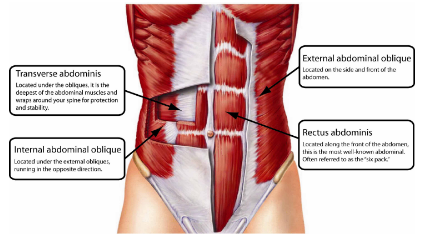What is Intra-Abdominal Bracing and How does it Work?
If you have ever been in a gym or worked with a trainer, I’m sure you’ve heard them cue you by saying “brace your core”. What does that even mean?! Should we be squeezing those abdominal muscles like we are flexing for a bodybuilding championship? Should I be wearing a weightlifting belt at all times? What does bracing even do for me? Today’s blog will break down all of the important information behind intra-abdominal bracing and its benefits!
Before diving into the meat and potatoes of bracing, we need to review what the “core” is. Think of your core as a 360* belt that wraps around the entire cylinder-like abdomen. We often forget that our abdominal cavity is three-dimensional! Our core muscles are not just the 6-pack abs that our rectus abdominus can provide. The core is a group of muscles including the rectus abdominus, obliques, transverse abdominus and lumbar multifidi. This is not including other accessory muscles or muscle groups such as the diaphragm and pelvic floor muscles as well, which help support our abdomen during bracing. All of these structures will help to provide security and stabilization for our spine during daily activities.
Intra-abdominal bracing is not just the contraction of these muscles. In fact, it is quite the opposite! This technique uses our breathing to create a pressurized system within the abdominal cavity, thus locking our spine in place for support. The reason powerlifters utilize a weightlifting belt during their lifts is actually to gain feedback from proper bracing! The pressure that is created from sufficient intra-abdominal bracing will cause the abdomen to push out against the entire belt (front, back & sides), which creates a signal for us to then contract the abdominal muscles and maintain that rigidity during weightlifting activities.
Bracing is incredibly important in helping to rehabilitate and resolve lower back pain. Start off by placing your hands on your abdomen and taking a deep breath through the belly. You should NOT feel or see your chest rise when making this breath. You should actually feel your abdomen press out and inflate into your hands. This is the feedback you want when performing a good brace. At that time, you can maintain that internal pressure and contract the core musculature to lock in that stable sensation. Early on, you can practice this technique in simple, safe positions such as lying on your back, sitting in a chair or standing. As you become more proficient and confident in this technique, it is time to begin working into core stabilization exercises while bracing. Finally, if your goal is to get back to weightlifting, you can practice intra-abdominal bracing with your lifts, maintaining adequate spinal support throughout the movement. Try these techniques for 10 repetitions with a 10 second hold for each brace. Perform a few sets everyday and progress to different movements when ready.
If you are looking to improve your weightlifting technique, we are offering a special edition Barbell Performance Class, starting on Tuesday, April 13th at 6:45pm! This is a 6-week course that will cover several different exercises, including education, anatomy, dynamic warm-ups, corrective exercises, technical breakdown and practice! Click the button below to learn more about this course and register! Hurry up, there are only a few spots left!
If you are suffering from lower back pain and would like to have the experts at Restore Physical Therapy evaluate your injury, click the button below to schedule a FREE Discovery Session! The specialists here at Restore will analyze your injury, discuss your goals and develop a unique plan, specific to you, in order to help you overcome your injuries and return to your favorite activities!





